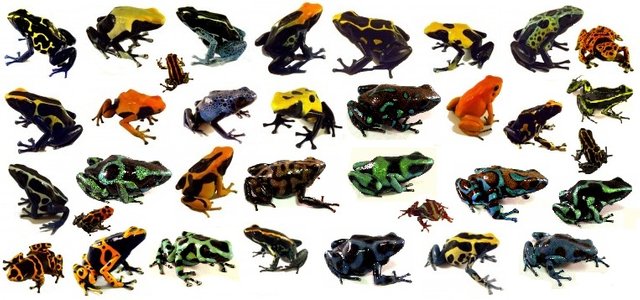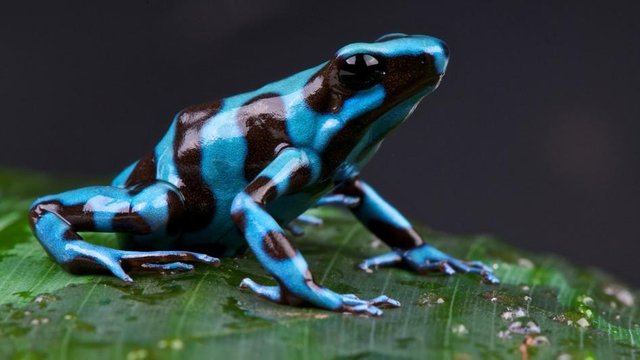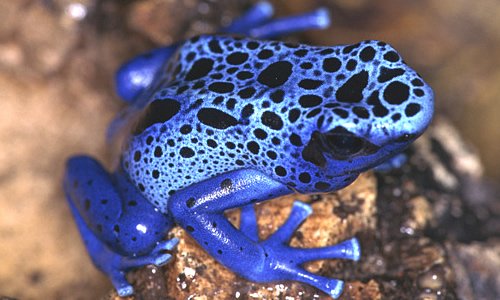There are hundreds of poisonous species of frogs and toads found throughout the world, but the most famous by far are the vibrantly colorful poison dart frogs found in the tropics of Central and South America. Instead of blending in to their surroundings to avoid being eaten, these amphibians produce potent toxins that can be deadly when they are eaten by predators or absorbed through the skin; natives even coated their arrows with the poison, giving giving rise to the name poison dart (or poison arrow) frog. As a result of their toxicity, these frogs have evolved truly stunning colors and patterns as a means of warning potential predators away.

We know quite a bit about these beautiful amphibians and their poisons, but there is a question that has had herpetologists scratching their heads for decades: how do the frogs avoid poisoning themselves? At first, it might seem like a ridiculous question; if the amphibians are producing the poison, one might think they must be automatically immune right? It's not something most of us consider, but the more you ponder the question, the more interesting it becomes. These frogs are able to produce some of the most potent poisons on Earth (the skin of the golden dart frog can easily kill 100 adult humans [source]), capable of harming or even killing a large number of different species. Yet dart frogs and other amphibians are known to be incredibly sensitive animals; even a seemingly inconsequential amount of chemicals or pollutants can be a death sentence for entire populations. So how are these animals, so vulnerable to most toxins and pollutants, able to produce such powerful poisons at no risk to themselves?

Being toxic to predators is a huge evolutionary advantage, but there is more to developing such a potent weapon than just making up some poison. A animal must be able to tolerate its own weapon before it can deploy it against other species. This is why biologists believe that there aren't more poisonous or venomous species of animals in the world.
"Being toxic can be good for your survival -- it gives you an edge over predators. So why aren't more animals toxic? Our work is showing that a big constraint is whether organisms can evolve resistance to their own toxins." -Rebecca Tarvin, a postdoctoral researcher at UT Austin Source
Scientists at the University of Texas at Austin have found the answer to the question for a subgroup of poison frogs that use the toxin epibatidine. If consumed by a predator, the frog's toxin binds to receptors in the predator's nervous system, causing hypertension, seizures, and even death. The presence of a tiny genetic mutation in the frogs explains why they aren't susceptible to the same fate; a change of just three of the 2,500 amino acids that make up the receptor prevents the toxin from binding to their own receptors. What is most impressive is that precisely the same change appeared independently three times in the evolution of these frogs.

To picture the process more clearly, imagine a cell and imagine that the protein receptor is a locked gate on the edge of the cell. Signals moving between the interior and exterior of the cell have to pass through the gate, however the receptor gate remains locked unless it is "opened" with the proper key. When a molecule with just the right shape comes along, the receptor is unlocked and transmits a signal. However, the toxin epibatidine behaves much like a skeleton key, able to activate virtually any receptor gate it comes in contact with, hijacking the cell and initiating a potentially life-threatening burst of activity. The frogs' genetic mutation prevents the toxin from binding to their own receptors; essentially, they've replaced the lock so it can't be opened by the skeleton key. Even more impressively, thanks to a second mutation, they have retained a means for the "real keys" to work on their receptors.

This research could have practical uses in human medicine. The data the team collected, which demonstrates how certain poisonous frogs block their own potent toxin while retaining use of receptors the brain needs, provides crucial information about epibatidine and how it functions in the body. The findings could eventually prove helpful in designing drugs such as new pain relievers or drugs to fight nicotine addiction.
"Every bit of information we can gather on how these receptors are interacting with the drugs gets us a step closer to designing better drugs." -Cecilia Borghese, research associate in the university's Waggoner Center for Alcohol and Addiction Research Source

Article Link: https://www.sciencedaily.com/

That was really cool ! I never thought why poisonous frogs don't poison themselves. Thanks, i am following you so i can learn more interesting stuff.
Downvoting a post can decrease pending rewards and make it less visible. Common reasons:
Submit
Great lesson and key analogy. I wonder if their poison leaves a residue on the vegetation, rocks or land it travels on that can be caught "second hand". Any clues on that?
Downvoting a post can decrease pending rewards and make it less visible. Common reasons:
Submit
Thank you! The author of the article included the key analogy and I had to use it; really explains it quite simply for people who don't have a scientific background (or who suck at cellular bio like I do!).
That's a good question. I have to imagine that being slimy they do leave a tiny amount of residue, but I can't imagine it's enough to be particularly harmful...so long as you're not like licking leaves or anything lol. Also, the really poisonous ones live in the tropics where rain storms occur almost daily, so such residue is likely washed away fairly quickly. This is my best hypothesis, I actually haven't heard anything on the subject of poisonous frog residue!
Downvoting a post can decrease pending rewards and make it less visible. Common reasons:
Submit
Downvoting a post can decrease pending rewards and make it less visible. Common reasons:
Submit
Beautifull animal and keep it up😍
Downvoting a post can decrease pending rewards and make it less visible. Common reasons:
Submit